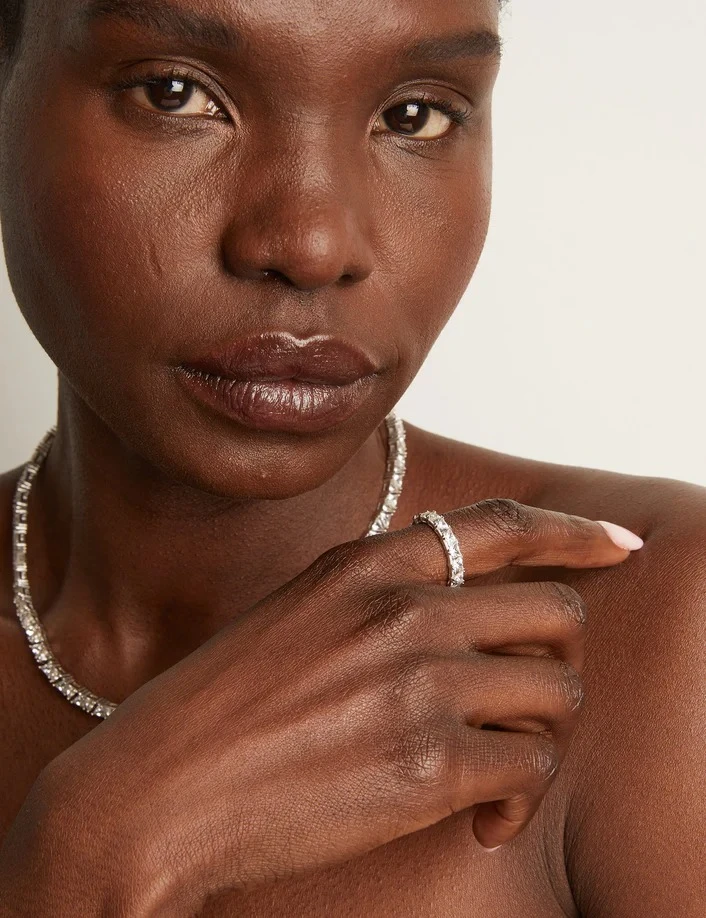
Necklaces
•07 min read
Selecting the perfect diamond necklace can feel overwhelming. Whether you're treating yourself to an investment piece or searching for the ideal diamond necklace gift, the choices seem endless. From understanding diamond necklace styles to evaluating quality and craftsmanship, making the right choice requires knowledge. This guide breaks down the 9 crucial factors to consider, ensuring your diamond necklace purchase is worthy of those who wear it.
The 4 Cs form the foundation of diamond evaluation. Cut determines how light reflects through the stone. Color grades range from colorless to yellow. Clarity measures internal flaws called inclusions. Carat refers to the diamond's weight. Each C affects the stone's overall value and appearance.
Higher grades in each category increase the price exponentially. A flawless, colorless diamond costs significantly more than one with visible inclusions or color. However, the impact varies by category. Cut quality affects sparkle most dramatically. Color matters less in yellow gold settings where slight warmth looks natural.
Cut takes priority for necklaces viewed from a distance. A well-cut diamond with lower color or clarity grades often appears more brilliant than a poorly cut stone with higher grades. Focus your budget on excellent cut quality first, then balance other factors based on your preferences and budget.
Classic diamond necklace styles include tennis necklaces with continuous stones, pendant styles featuring a single focal diamond, and station necklaces with diamonds spaced along the chain. Rivière necklaces showcase graduated diamonds for maximum impact. Each style serves different occasions and personal preferences.
Delicate pendant styles work with both casual and professional looks. Tennis necklaces add instant polish to evening wear. Station necklaces offer versatility for layering or wearing alone. Consider your lifestyle when choosing. A downtown individualist might prefer edgy geometric settings, while established professionals often gravitate toward timeless designs.
Contemporary styles embrace mixed metals and unconventional settings. Asymmetrical designs and organic shapes gain popularity. Lab-grown diamonds enable larger carat weights at accessible price points. Sustainable materials and ethical sourcing drive purchasing decisions. The focus shifts from trendy to investment-quality pieces with lasting appeal.
Choker length (14-16 inches) sits close to the neck. Princess length (17-19 inches) falls just below the throat. Matinee length (20-24 inches) reaches the chest. Opera length (28-34 inches) allows for doubling or dramatic single strands. Each length creates different visual effects and serves various styling purposes.
Use a soft measuring tape around your neck where you want the necklace to sit. Add 2-4 inches for comfortable movement. Consider your torso length and neck shape. Shorter necks benefit from longer lengths that create vertical lines. Fuller figures often look best in princess or matinee lengths.
High necklines pair well with longer chains that extend below the garment. V-necks complement princess length necklaces that mirror the neckline's shape. Strapless tops showcase choker or princess lengths. Consider proportions carefully. The goal is creating balance and drawing attention to your best features.
Pro Tip
When selecting a diamond necklace, pay special attention to the cut quality of the stones. A well-cut diamond maximizes light reflection, giving your necklace coveted sparkle and brilliance, even in smaller carat weights. This means you can achieve stunning visual impact while staying within budget.
Gold offers warmth and variety in 14k and 18k options. Yellow gold complements warmer skin tones and provides vintage appeal. White gold mimics platinum at a lower cost but requires periodic re-plating. Platinum delivers durability and hypoallergenic properties but costs more. Rose gold adds contemporary flair but may not suit all diamond colors.
White metals make diamonds appear whiter by contrast. Yellow gold can mask slight color in lower-grade stones, making them appear warmer rather than yellow. The setting metal becomes part of the overall design aesthetic. Consider which metals you already wear to ensure cohesive styling.
Platinum offers the purest option for sensitive skin. High-quality 14k and 18k gold typically cause fewer reactions than lower karat alternatives. Avoid nickel-containing white gold alloys if you have known sensitivities. Look for responsibly sourced metals that undergo quality testing for purity and safety.
Examine prong security and symmetry. Well-crafted settings hold stones firmly without visible gaps. Smooth finishes indicate attention to detail. Check for consistent metal thickness throughout the piece. Quality settings undergo rigorous wear-testing to ensure durability for real life situations.
Prong settings maximize light exposure for brilliance. Bezel settings offer security for active lifestyles. Channel settings create smooth lines with protected stone edges. Each style affects both appearance and practicality. Consider your daily activities when choosing setting types.
Secure prongs prevent stone loss during normal wear. Look for rounded prong tips that won't catch on clothing. Multiple prongs distribute stress better than fewer larger ones. Quality craftsmanship includes proper prong height and placement for both security and beauty.
Many smaller diamonds can create more sparkle than one large stone of equal weight. The eye perceives continuous light reflection as more brilliant. However, larger individual stones command attention and prestige. Consider which effect aligns with your style preferences and intended use.
Graduated arrangements create elegant flow from larger center stones to smaller sides. Uniform sizing offers consistent sparkle. Alternating sizes add visual interest and movement. The arrangement affects how light travels through the piece and impacts overall brilliance.
Single large diamonds make bold statements and often appreciate in value better. Multiple smaller stones offer more design flexibility and typically cost less per carat. Consider maintenance requirements. Multiple stones mean more settings to inspect and potentially more repair needs over time.
Certification provides unbiased quality assessment from independent laboratories. It documents the 4 Cs and identifies any treatments. This information protects your investment and ensures you receive what you pay for. Certification also aids in insurance claims and future resale.